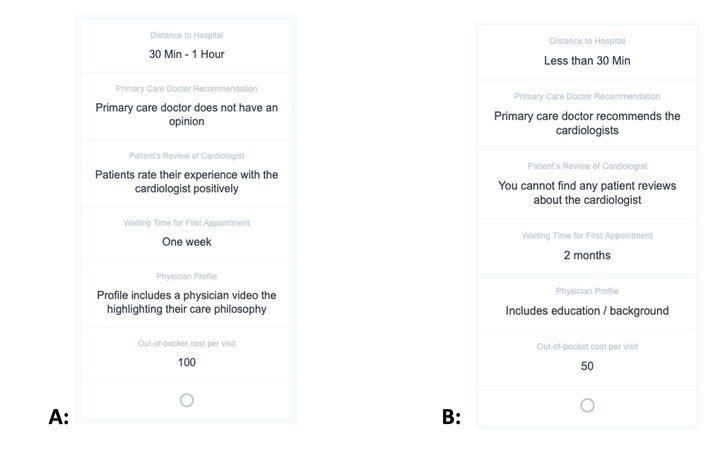News & Insights
News & Insights
BY Erin Hotchkiss
Co-authored by Kat Morgan, Director of Analytics, BPD
Research techniques to answer the million-dollar marketing question.
The average American makes up to 35,000 decisions a day. Can I hit snooze one more time on my alarm? Should I drive to the office today? What should we eat for dinner? Which toothpaste should I buy? And on… and on.
When it comes to healthcare decisions, things are much more complex. Should I go to the doctor for this joint pain? Do I need a new PCP? What is this chest pain… is this an ED thing or an urgent care issue?
Healthcare organizations have to understand how consumers make decisions—and also know when to intercept them in those moments so folks can get the life-saving care they need.
However, understanding complex decisions isn’t simple. Traditional research methodologies like focus groups, interviews, and surveys focus on self-reported data alone. Ask someone about their behavior and they’ll tell you honestly… right?
Wrong. Marketers have learned the hard way that self-reporting can be deceiving. Consumers may say something is important when making a decision about care, but their actions prove otherwise. For example: a cardiology patient may say they did extensive research to find their cardiologist. In reality? The specialist’s convenient location was the tiebreaker.
So how do you really understand what impacts consumer decisions?
Enter data science.
At BPD, we couple traditional research methods with data analysis—including patient data, behavioral data, and more. One example of this is a technique with a fancy name: conjoint analysis. It helps us get to the core truth about how people make complex choices.
Here’s how we do it.
Focus and prioritize marketing initiatives
Start with a behavioral situation.
In a recent study, BPD asked consumers to imagine that they or a family member was diagnosed with a heart-related disease—and needed to find a cardiologist. We wanted to understand what factors influence the decision the most. Is it the PCP’s recommendation? Ratings and reviews? Location? Credentials?
Here’s what we found.
What people said was “extremely important” (without conjoint)
With traditional survey methods, you’re relying on what people say and what they self-report. With these methods, peoples’ past experiences with a cardiologist rises to the top. Does the cardiologist treat me with respect? Do they clearly explain things? 71% and 69% of respondents, respectively, answered that these elements are important.
Looking at reputational measures, 60% look for a positive reputation of the hospital; 55% react to positive patient reviews; and 35% seek recommendations from primary care physicians.
That all seems straightforward enough.

What was actually important when making the decisions
Now, let’s layer on a conjoint analysis. We put isolated factors into context for participants to understand where they might make trade-offs. This is a bit of a simulation… if you needed to select one, which would you choose?
For example: Cardiologist A has positive patient reviews but is farther away and more expensive. Is that worth it? Or would you opt for the Cardiologist B that’s closer and fewer out-of-pocket cost?

We found that patient reviews, followed by a primary care physician’s recommendations, were the most important attributes. When these factors existed, patients were less concerned about the distance to the hospital or physician profiles.
This is great news for providers whose offices require longer drive times. It also gives insight into where to spend valuable marketing effort. For example, it may be far more beneficial to focus on amping up patient reviews and referral marketing as opposed to cranking out ads with messaging like “quality care close to home.”
This kind of research can help healthcare organizations establish marketing priorities based on what will actually impact the business.
Represent the voice of the consumer
Research like this can help healthcare marketers to segment their audiences based on their true behavior. By identifying consumer personas with distinct priorities, marketers can tailor messaging and right-size efforts to resonate with each group, maximizing engagement and response rates.
In our analysis, we overlayed different demographic attributes to build profiles of what’s important to different audiences.
For women, patient reviews were more important. Whereas for men, a primary care doctor’s recommendation is more important.
Think about this in context to service lines like Women’s Health… women may be more receptive to stories of other women and seek to hear about experiences of those like them.
The impact of cost
Price transparency is a big, hairy challenge for healthcare organizations. Yet, there’s a constant debate about how impactful cost really is.
So, let’s use this methodology to find out the truth. Below is a high-level summary of what we found when we included cost as a factor—for women, cost is more important than for men—and almost as important as primary care doctor’s recommendation.

Why do patients choose you?
One of the key questions healthcare marketers must answer is—why us? Why do patients choose your offering over competitors? What messages are most impactful in marketing? What proof points will impact choice?
Having answers to these questions allows marketers to dial up or down specific messages based on current offerings, identify new opportunities to attract patients, and even inform operational improvements or new service offerings.
These are just some of the findings from this recent study. But we didn’t stop there. At BPD, we’re constantly studying consumer behavior to understand decision-making. It’s our job—and evening hobby—to understand consumers as health consumers.
Want to learn more? Need to know what’s impacting your audiences’ healthcare decisions? Shoot us a note at insights@bpdhealthcare.com. We’d love to nerd out with you.
Related Blog Posts
Stay in Touch
Stay in Touch
Receive our updates, industry news and insights.



